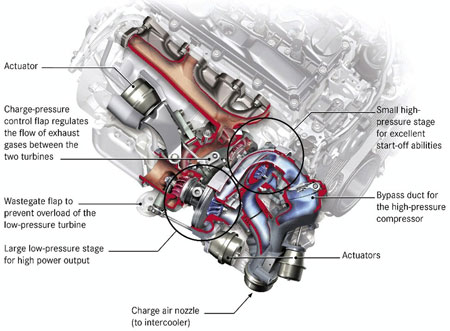
A twin turbocharged inline-4 diesel engine producing 204 horsepower? Sounds familiar but we are not taking another look at the engine powering the BMW 123d again here, instead this is Mercedes-Benz’s new OM651 turbodiesel engine, which is available in 3 stages of tune.
In the 250 CDI state of tune, the 2,143cc turbodiesel produces 204 horsepower at 4,200rpm and 500Nm of torque between 1,600rpm and 1,800rpm. Two lower states of tune are available - a 220 CDI tuning which results in 170 horsepower between 3,200rpm and 4,800rpm and 400Nm of torque between 1,400rpm and 2,800rpm, and another 200 CDI tuning produces 136 horses between 3,000 and 4,600rpm, and 330Nm of torque between 1,600rpm and 2,800rpm. Installed in the W204 C-Class, the 204 horsepower engine pushes it up to 100km/h in a mere 7.7 seconds, with 60 to 120km/h taking 9.4 seconds.
The twin turbochargers are installed in a sequential manner, with one high pressure small turbocharger spooling up quickly for low revs and the other low pressure large turbocharger taking care of the higher engine speeds. The high pressure turbo that serves the low revs has a bypass duct to prevent it from being overloaded, and it ceases work from medium engine speeds onwards.
The engine also has a fourth generation common rail system with 2,000 bar rail pressure, a big up from the previous generation 400 bar pressure. Maximum ignition pressure is 200 bar, and injectors are piezoelectric.
For smoother operation, two Lanchester balancer shafts with low-friction roller bearings help counter the vibration inherent with inline-4 designs. The engine’s forged crankshaft also has eight counterweights turns supported by five bearings. Conrods are made of forged steel, with weight optimised by Mercedes-Benz engineers. The aluminium pistons slide up and down in cast-iron barrels for minimum frictional resistance.
Lastly, the engine uses a two-mass flywheel which connects a primary flywheel to a secondary one by use of springs to isolate the crankshaft’s vibration from the drivetrain.







